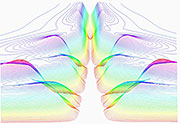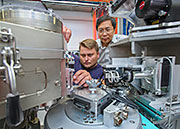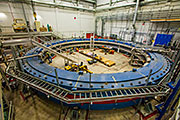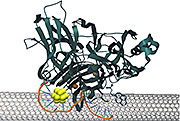For Dr. Brenda Garcia-Diaz of DOE's Savannah River National Laboratory, job satisfaction and collaboration have gone hand in hand, and have led to official recognition within her adopted home state.
“The best part of the job has been working with people,” she says. “I’m impressed with the depth of knowledge that is in SRNL, and I have seen over and over how we can target very difficult problems by getting the right people together and forming effective teams.
“It’s been great to see and work with people with different backgrounds who can open your mind … To address the challenges we face today, it requires teams with deep backgrounds in a variety of skill sets. I have been lucky to have several opportunities where teams started with nothing and created something great by combining different knowledge and experiences.”
Full Story
Feature
The household refrigerator, sitting in the corner of virtually every U.S. kitchen, has been essentially the same for almost 100 years; air-conditioning, based on the same technology, almost 75 years. But with the traditional vapor-compression model reaching its limits for advancement in efficiency, cooling still eats up as much as one quarter of U.S. daily energy consumption.
So, what if refrigeration systems could be even better? What is the future of cool? DOE’s Ames Laboratory, together with the larger scientific community, believes it could be magnetic cooling, a refrigeration system which exploits the magnetocaloric effect—a temperature change of a material caused by exposing it to a changing magnetic field. Scientists have been attempting for years to push this promising energy-efficient alternative over the gap between fundamental research and applied technology.
Full Story
See also…
 An international team of researchers, including the MESA+ Institute for Nanotechnology at the University of Twente in the Netherlands and DOE’s Argonne National Laboratory, announced in Science the observation of a dynamic Mott transition in a superconductor.
An international team of researchers, including the MESA+ Institute for Nanotechnology at the University of Twente in the Netherlands and DOE’s Argonne National Laboratory, announced in Science the observation of a dynamic Mott transition in a superconductor. Imagine a gas giant planet like Jupiter. Where does the surface begin and the atmosphere end? Questions like these can be answered by understanding the boundaries between phases of matter, which we sometimes think of as delineated by strong boundaries.
Imagine a gas giant planet like Jupiter. Where does the surface begin and the atmosphere end? Questions like these can be answered by understanding the boundaries between phases of matter, which we sometimes think of as delineated by strong boundaries.  Two years ago, scientists on the Muon g-2 experiment successfully brought a fragile, expensive and complex 17-ton electromagnet on a 3,200-mile land and sea trek from DOE’s Brookhaven National Laboratory in New York to Fermi National Accelerator Laboratory in Illinois.
Two years ago, scientists on the Muon g-2 experiment successfully brought a fragile, expensive and complex 17-ton electromagnet on a 3,200-mile land and sea trek from DOE’s Brookhaven National Laboratory in New York to Fermi National Accelerator Laboratory in Illinois.  With fossil-fuel sources dwindling, better biofuel cell design is a strong candidate in the energy field. In research published in the Journal of the American Chemical Society, researchers at DOE's Los Alamos National Laboratory and external collaborators synthesized and characterized a new DNA-templated gold nanocluster (AuNC) that could resolve a critical methodological barrier for efficient biofuel cell design.
With fossil-fuel sources dwindling, better biofuel cell design is a strong candidate in the energy field. In research published in the Journal of the American Chemical Society, researchers at DOE's Los Alamos National Laboratory and external collaborators synthesized and characterized a new DNA-templated gold nanocluster (AuNC) that could resolve a critical methodological barrier for efficient biofuel cell design.

